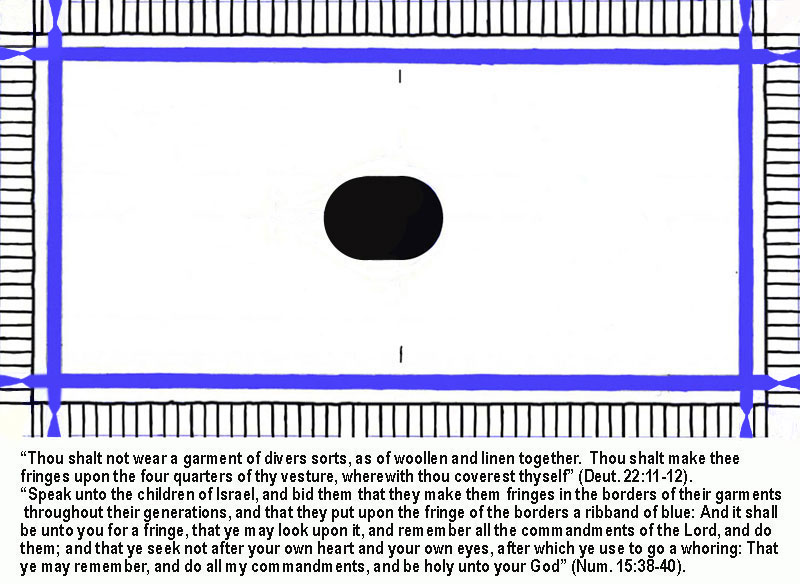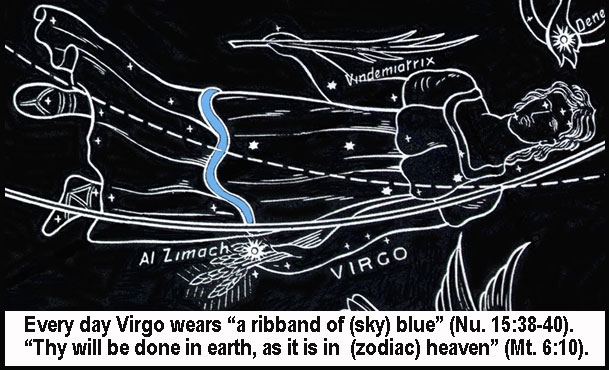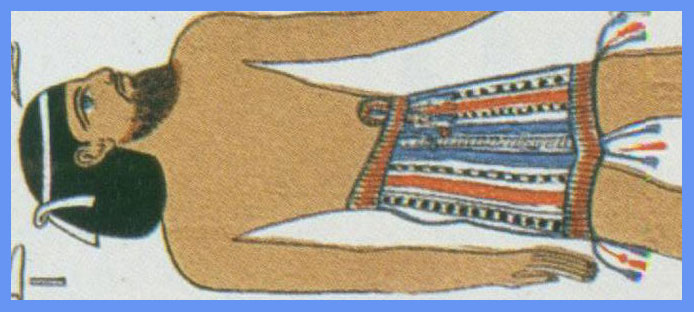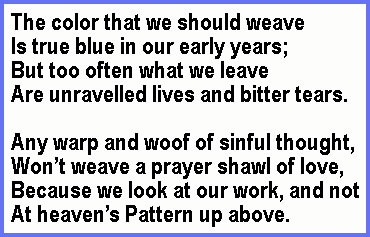
Should Christians Wear Blue TASSELS?
Should Christians wear "TASSELS" (Deut.22:11-12) and attach "a VIOLET thread" (Num. 15:38-40; NEB) to them? Christ said he came not "to destroy the law" (Matt.5:17). Jesus wore an outer garment with a "BLUE or VIOLET" (p.101, Young's Concordance; Wilson's O.T. Word Studies, p.43) thread attached to each TASSEL (tsitzith) on the four corners of his poncho-like robe (tallith). Use both colors just to be safe. Esther 8:15 seems to imply VIOLET and I.S.B.E. 2:363 says, "Originally they contained a VIOLET thread." Yet according to Maimonides, it was the color of the clear noon sky (PALE INDIGO) (Yad Tzitzith 2:1; Kley HaMikdash 8:13). Rashi, on the other hand, writes that it was the color of the evening sky (GREENISH BLUE) (Rashi on Num. 14:41). Later authorities asserted that it was a DARK GREY-BLUE (Rabbi Gershon Henoch of Radzin, Shefuney Temuney Choi. 3 (p. 36). "Behold, I come as a thief. Blessed is he that watcheth and keepeth his garments, lest he walk naked, and they see his shame" (Rev. 16:15).
When a woman touched a TASSEL, her continuous menstrual flow finally was healed (Luke 8:44). When others touched his TASSELS, they were also healed (Mark 6:56). "Border" or "hem" is not the meaning in these passages. The Greek word "kraspedon" means "TASSEL, fringe, extremity" (p.105. Young's Concordance). Jesus set us "an example" (1 Pet.2:21). The first act of a devout Jew in his morning prayer is to put the TASSELS to his LIPS and kiss them to acknowledge that he will obey all 613 laws in the Old Testament. As Christ said, "This people ... honoureth me with their LIPS; but their heart is far from me" (Matt.15:7-8). Christ didn't condemn this honourable custom, so maybe we should kiss our TASSELS too. Christ merely condemned the Pharisees and scribes for their hypocrisy. They wanted "to be seen of men; they ... enlarge the borders (#2899 -- TASSELS) of their garments" (Matt.23:5). They "appear beautiful outward, but are within full of ... uncleanness... (They) outwardly appear righteous unto men, but within (are) ... full of ... iniquity" (23:27-28). Christ didn't condemn their righteous or beautiful appearance, so we should appear this way too and wear TASSELS attached to BLUE and VIOLET cords. Jesus arose "with healing in his wings (#3671 -- CORNERS)" (Mal. 4:2) so that the sick could "touch the hem (#2899 -- TASSEL) of his garment; and as many as touched were made perfectly well" (Matt. 14:36). Zephaniah 1:8 says, "I will punish the officials and the king's sons, and all who DON a FOREIGN VESTMENT" (without fringes?). Numbers 15:38-40 says, "Speak to the children of Israel (not men only) and instruct them to make for themselves FRINGES on the corners of their garments throughout the generations; let them attach a cord of BLUE to the FRINGE at each corner. That shall be your FRINGE; look at it and recall all the commandments of the Lord and observe them, so that you do not follow your heart and eyes in your lustful urge. Thus shall you be reminded to observe all my commandments and to be holy to your God." How does a blue thread attached to the hem of a garment remind us of God's law? Perhaps "Life UNRAVELS without God's law." Both men and women are required to wear blue tassels since "ben" ("sons" or "children" #1121 Strong's) elsewhere refers to all those who must avoid unclean meats (Lev. 11:2) -- which would include women.
Jesus condemned the Pharisees in Matthew 23:5 by saying, "But all their works they do to be seen of men; they make broad their phylacteries, and ENLARGE the borders (TASSELS) of their garments." T.B. Menahot 41b says, "How many threads must one insert? Beth Shammai say, FOUR; but Beth Hillel say, THREE. And how far must they hang down? Beth Shammai say FOUR (fingerbreadths); but Beth Hillel say THREE (fingerbreadths)." Jesus sided with Hillel's view that it is sufficient to insert THREE threads into the hole at each corner of the garment, and then double them in the middle so that six hang down, with THREE fingerbreadths of loose thread after the windings and knots. Furthermore, Hillel agreed with Jesus by saying, "He who makes a WORLDLY use of the crown of the Torah shall waste away" (Aboth 1:13). According to Maimonides, it was the color of the clear noon sky (PALE INDIGO) (Yad Tzitzith 2:1; Kley HaMikdash 8:13). Rashi, on the other hand, writes that it was the color of the evening sky (GREENISH BLUE) (Rashi on Num. 14:41). Later authorities asserted that it was a DARK GREY-BLUE (Rabbi Gershon Henoch of Radzin, Shefuney Temuney Choi. 3 (p. 36). The Hebrew word "Tzitzith" in gematria equals 600. In addition there are seven knots and six strands. The total is 613, which is the exact number of commandments in the Torah.
God said to look at the tsitzith and "remember my commandments" (Num. 15:37-41). Therefore some Jews go further: "A long cord is wrapped around five shorter cords first ten times, then five, then six and finally five times, each series being separated from the others by a double square knot. Three double square knots precede the the whole series. The number ten suggests Y (
In many Sephardic communities, the groom traditionally wears a TALLIT under the chuppah (wedding canopy). This is also the custom in German Jewish communities. At Jewish wedding ceremonies, a TALLIT is also often used as a CHUPPAH or wedding canopy. Therefore the TALLIT is a "WEDDING GARMENT." It should be "white raiment" (Rev. 3:19) with a "thread of blue" and four tassels. In Christ's parable, one of the wedding guests did not have on a WEDDING GARMENT(Matthew 22:1-14). This was not acceptable to our Lord. Therefore, during the Feast of Trumpets and Day of Atonement, both WEDDING ceremonies, we must wear PRAYER SHAWLS or TALLITS. The CORNERS of the prayer shawl are often called WINGS, since they formed WINGS when the arms were held out. The same word used in Numbers 15:38 for CORNER is used in Malachi 4:2 for WINGS. With this understanding in mind, an ancient Jew under the prayer shawl could be said to be dwelling in the secret place of the Most High and under His WINGS (Ps. 91:1-4).
In Bible times, Jewish men wore this TALLIT all the time -- not just at prayer. TALITH contains two Hebrew words: TAL meaning tent and ITH meaning little. Thus you have a LITTLE TENT. Each man had his own LITTLE TENT as a prayer closet. Paul was a Pharisee, but also a TENTMAKER (Acts 18:3). Many believe he made PRAYER SHAWLS rather than tents to live in. The Tent of Meeting that was set up in Old Testament times, was unable to hold millions of Jews. Therefore each man was given his own private sanctuary where he could meet with God. One for each man. Each man would pull it up over his head, forming a TENT, where he would begin to chant and sing his Hebrew songs, and call upon Yahweh. It was private and set apart from anyone else (Matt. 6:6) -- which enabled them to focus wholly on God.
The lady with the issue knew that if Jesus were the promised Messiah, there would be healing in His WINGS (fringes). That this was the opinion of many other people is revealed by the crowd who sought his healing powers, "that they might only touch the HEM of his garment: and as many as touched were made perfectly whole" (Matt. 14:36). "But unto you that fear my name shall the Sun of righteousness arise with healing in his WINGS" (Malachi 4:2).




"Do His will as if it were your own, so that He will do your will as if it were His. Nullify your own will before His so that he will nullify the will of others before you" (Pirke Avot 2:4).
"To all other pleasures prefer this -- to know that you are obeying God, and performing, not in word but in deed, the duty of a wise and good man." (Epictetus 3:24)
"Seeing thou hatest instruction, and cast my words behind you ... consider this, you who forget God ... to him that ordereth his conduct aright will I show the salvation of God" (Ps. 50:17-23).